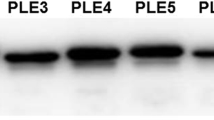Abstract
Pig liver esterase (PLE) is probably the most important carboxyl esterase in organic synthesis and is commercially obtained by extraction of the animal tissue. However, problems occur in its application due to the presence of several isoenzymes (α-, β- and γ-PLE). The functional expression of the γ-isoenzyme was already shown and differences in the enantioselectivity compared to the commercial preparations were confirmed. The amino acid and nucleotide sequences of the α- and β-PLE are still unknown. In this work, putative sequences of the α-isoenzyme were identified from a commercial PLE preparation by 2D gel electrophoresis, digestion with proteases and analysis using Matrix-assisted laser desorption/ionization–time of flight (TOF) and electrospray ionisation quadrupole–TOF mass spectrometry. Based on these results, three amino acid exchanges were introduced into the gene encoding γ-rPLE by site-directed mutagenesis, and the proteins were expressed in E. coli Origami (DE3). The produced PLE mutants were characterised with respect to their substrate specificity and enantioselectivity. No significant differences in the activity towards methyl butyrate were found, but several variants showed substantially enhanced enantioselectivity in the resolution of (R,S)-1-phenyl-2-butyl acetate with E = 100 for the best mutant V236P/A237G.





Similar content being viewed by others
References
Barker DL, Jencks WP (1969) Pig liver esterase. Physical properties. Biochemistry 8:3879–3889
Bencharit S, Morton CL, Xue Y, Potter PM, Redinbo MR (2003) Structural basis of heroin and cocaine metabolism by a promiscuous human drug-processing enzyme. Nat Struct Biol 10:349–356
Bornscheuer UT, Kazlauskas RJ (2006) Hydrolases in organic synthesis—regio- and stereoselective biotransformations, 2nd edn. Wiley-VCH, Weinheim
Böttcher D, Brüsehaber E, Doderer K, Bornscheuer UT (2007) Functional expression of the γ-isoenzyme of pig liver carboxyl esterase in Escherichia coli. Appl Microbiol Biotechnol 73:1282–1289
Chen CS, Fujimoto Y, Girdaukas G, Sih CJ (1982) Quantitative analyses of biochemical kinetic resolutions of enantiomers. J Am Chem Soc 104:7294–7299
Faber K (2004) Biotransformations in organic chemistry, 5th edn. Springer, Berlin Heidelberg New York
Farb D, Jencks WP (1980) Different forms of pig liver esterase. Arch Biochem Biophys 203:214–226
Heymann E, Junge W (1979a) Characterization of the isoenzymes of pig-liver esterase. 1. Chemical studies. Eur J Biochem 95:509–518
Heymann E, Junge W (1979b) Characterization of isoenzymes of pig-liver esterase 2. Kinetics studies. Eur J Biochem 95:519–525
Heymann E, Peter K (1993) A note on the identity of porcine liver carboxylesterase and prolyl-β-naphthylamidase. Biol Chem Hoppe Seyler 374:1033–1036
Laemmli UK (1970) Cleavage of structural proteins during assembly of the head of bacteriophage T4. Nature 227:680–685
Lange S, Musidlowska A, Schmidt-Dannert C, Schmitt J, Bornscheuer UT (2001) Cloning, functional expression, and characterization of recombinant pig liver esterase. ChemBioChem 2:576–582
Musidlowska A, Lange S, Bornscheuer UT (2001) Via overexpression in the yeast Pichia pastoris to enhanced enantioselectivity: new aspects in the application of pig liver esterase. Angew Chem Int Ed 40:2851–2853
Musidlowska-Persson A, Bornscheuer UT (2002) Substrate specificity of the g-isoenzyme of recombinant pig liver esterase towards acetates of secondary alcohols. J Mol Catal B Enzym 19–20:129–133
Musidlowska-Persson A, Bornscheuer UT (2003a) Recombinant porcine intestinal carboxylesterase: cloning from the pig liver esterase gene by site-directed mutagenesis, functional expression and characterization. Protein Eng 16:1139–1145
Musidlowska-Persson A, Bornscheuer UT (2003b) Site directed mutagenesis of recombinant pig liver esterase yields mutants with altered enantioselectivity. Tetrahedron: Asymmetry 14:1341–1344
Öhrner N, Mattson A, Norin T, Hult K (1990) Enantiotopic selectivity of pig liver esterase isoenzymes. Biocatalysis 4:81–88
Takahashi T, Ikai A, Takahashi K (1989) Purification and characterization of proline-β-naphthylamidase, a novel enzyme from pig intestinal mucosa. J Biol Chem 264:11565–11571
Acknowledgments
We are grateful to the Deutsche Bundesstiftung Umwelt (DBU, Osnabrück, Germany, Grant No. AZ13071 and AZ13141) and the Service Center Biocatalysis (Degussa AG, Hanau, Germany) for financial support.
Author information
Authors and Affiliations
Corresponding author
Rights and permissions
About this article
Cite this article
Brüsehaber, E., Böttcher, D., Musidlowska-Persson, A. et al. Identification of pig liver esterase variants by tandem mass spectroscopy analysis and their characterization. Appl Microbiol Biotechnol 76, 853–859 (2007). https://doi.org/10.1007/s00253-007-1061-2
Received:
Revised:
Accepted:
Published:
Issue Date:
DOI: https://doi.org/10.1007/s00253-007-1061-2




